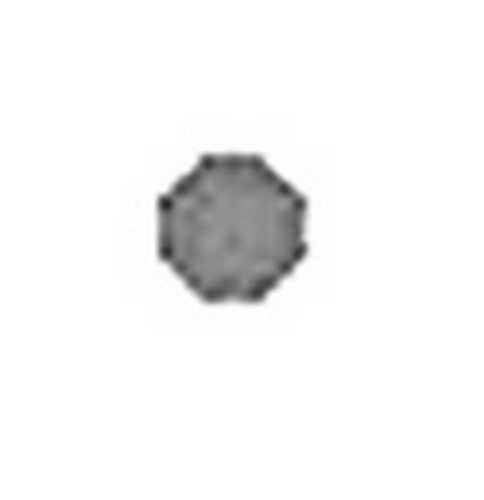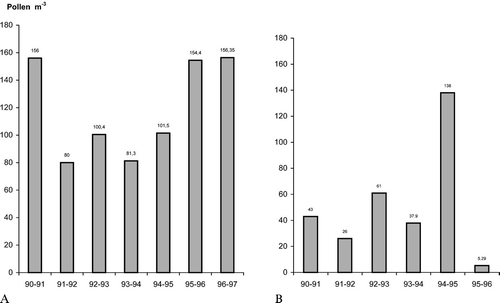Abstract
In order to find the qualitative and quantitative changes in airborne pollen concentrations in Delhi metropolis area an aerobiological survey was undertaken from September 1990 to August 1997. Air samples were collected daily using a Rotorod Aeroallergen Sampler at 10 m above the ground level. Ninety-four pollen types were recorded and the major contributors include Morus, Cannabis, Chenopod/Amaranth, Prosopis, Artemisia, and Eucalyptus. Ten pollen types contributed 90% of the total pollen load. Two major pollen seasons were recorded each year (February–April and September–November), although pollen grains in low frequency were recorded throughout the whole year. A significant reduction in pollen concentration was observed in subsequent years. The number of Morus, Cannabis, Prosopis, and Artemisia pollen decreased considerably while the number of Ricinus communis pollen did not show any considerable change during the study period. It is suggested that the reduction in pollen numbers from 1990 to 1997 in Delhi is due to massive clearing of vegetation for developmental activities of the city.
Average percent contribution of 10 dominant pollen types in Delhi atmosphere based on seven-year survey (1990–97).
Detailed information about daily, seasonal and annual variations of airborne pollen grains is of leading importance for an effective diagnosis and management of pollinosis. Long-term analysis of airborne pollen of a geographical region provides immense value in assessing the efficacy of immunotherapy with pollen antigens in respiratory allergy patients. In India, the seriousness of allergic diseases began in the sixties as more than 10% of the population suffered from major allergic illnesses (Vishwanathan Citation1964). In Delhi, several atmospheric surveys for airborne pollen have been carried out for qualitative and, in some cases, quantitative variations over the last three decades (Citation Citation Citation CitationDua & Shivpuri Citation1962, Singh & Shivpuri 1971, Singh & Babu 1981, 1982, Malik et al. 1990). However, in the recent years changes have taken place in the vegetation of Delhi region and exotic plants have been introduced in parks and gardens. In the present study a seven-year long survey was undertaken to find the qualitative and quantitative changes of airborne pollen concentrations in Delhi, India.
MATERIAL AND METHODS
The survey of airborne pollen concentrations in Delhi was carried out from September 1990 to August 1997. The samples were collected daily using an impaction Rotorod intermittent sampler (Rotorod Aeroallergen, Model 40; CitationPerkins Citation1957, Brown et al. 1993). The sampler was installed 10 m above the ground level at the former Center for Biochemical Technology, now, Institute of Genomics and Integrative Biology (Administrative Block) located in Delhi University, North Campus (). The sampling site was surrounded by densely populated area in the west, and Delhi Ridge covered by scrub jungle-type vegetation was located in the east. The original local vegetation was confined to a few isolated areas of the ridge–the northern most tail end of the Aravali Hills.
The sampling site located at the Institute of Genomics and Integrative Biology (Delhi University Campus) in Delhi Metropolis.
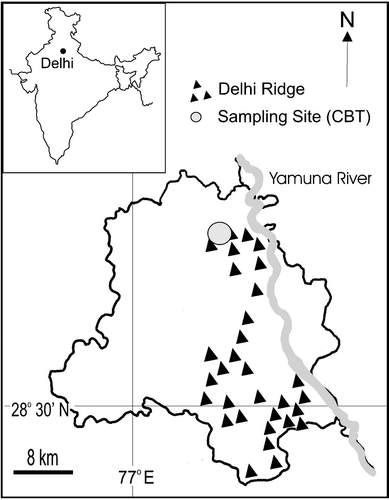
The sampler collects pollen on transparent plastic rods coated with silicon grease on one side. The rods were mounted on an armature, which spins at 2400 rpm/min. The pollen grains impacted on the rods were mounted in safranine stained glycerin jelly and examined under a light microscope. The pollen grains were identified based on the shape, number of apertures, size and ornamentation from reference preparations and published literature (Citation CitationSingh & Babu Citation1980, Lewis et al. 1984, Nair et al. 1986). The pollen counts are expressed as number of pollen m {\rm ^{ - 3}} air.
RESULTS
Diversity in atmospheric pollen flora
During the atmospheric survey conducted for seven consecutive years (1990–1997) a total of 94 pollen types were identified (Appendix I). Of these, 75 pollen types were identified down to genus or species level, while 20 (<0.1% of the total) were identified to the family level only.
Seasonal Variations
Monthly concentrations of all the pollen types for years 1990 to 1997 are illustrated in . Major pollen season in Delhi was from February to April with highest concentration in February 1991 (7270 pollen grains m {\rm ^{ - 3}} air). A second season was observed from September to November, pollen grains were present in variable concentrations throughout the whole year.
Seasonal variations in the total atmospheric pollen concentration (pollen m {\rm ^{ - 3}} air) in Delhi (1990–97).
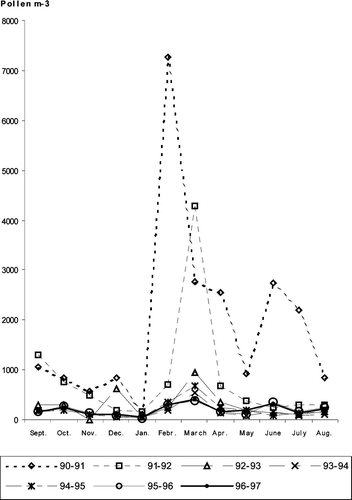
Month-to-month variation for the pollen concentration in each year investigated is presented in .
Monthly total pollen concentration (pollen m {\rm ^{ - 3}} air) in Delhi during 1990–97: A. Morus; B. Cannabis.

Monthly total pollen concentration (pollen m {\rm ^{ - 3}} air) in Delhi during 1990–97: A. Poaceae; B. Chenopod/Amaranth.

Monthly total pollen concentration (pollen m {\rm ^{ - 3}} air) in Delhi during 1990–97: A. Prosopis; B. Artemisia; C. Eucalyptus.

Monthly total pollen concentration (pollen m {\rm ^{ - 3}} air) in Delhi during 1990–97: A. Parthenium; B. Xanthium; C. Ricinus.
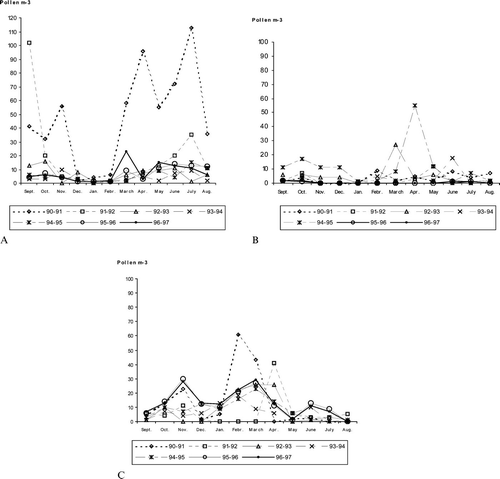
Morus alba. – Morus pollen grains show a very short season from February to March each year with maximum concentration (5835 pollen m {\rm ^{ - 3}} air) in February 1991 (). However, typically, the yearly peak was observed in March.
Cannabis sativa. –Although Cannabis sativa pollen grains were sporadically recorded in each month, normally the counts started slightly increase in January, and the main season was found from May to August. The maximum concentration of 1784 pollen m {\rm ^{ - 3}} air was observed in June 1991 ().
Poaceae. – Except November 1992, the Poaceae pollen grains were recorded in every month during the investigation period. Two major seasons were observed, first one in January–May and the second one from August to November (). The highest pollen concentration was recorded in September 1990 with 596 pollen m {\rm ^{ - 3}} air {\rm ^{3}} , followed by 483 pollen m {\rm ^{ - 3}} air in April 1991. The peak pollen season was generally in September.
Chenopodiaceae – Amaranthaceae (Chenopod/Amaranth). – Pollen grains of Chenopod/Amaranth were recorded each month but in November 1992. The yearly peak pollen seasons were in February–May and in September–November (). The highest pollen concentration during the investigation period was recorded in April 1991 (304 pollen m {\rm ^{ - 3}} air). Gradual reduction in concentrations in subsequent years was observed in each month.
Prosopis juliflora. – The major pollen season for Prosopis juliflora was recorded from March to April with a peak in April (). The highest pollen concentration (398pollen m {\rm ^{ - 3}} ) was recorded in April 1991. Each year a secondary season was found from October to December with the peak concentrations in November. A gradual reduction of the number of pollen in each month in subsequent years was recorded.
Artemisia scoparia. – Although pollen of Artemisia was sporadically recorded throughout the year, the major pollen season was in September–November with the highest concentration in October 1990 (224 pollen m {\rm ^{ - 3}} ; ). In subsequent years a gradual decline in pollen concentration was observed.
Eucalyptus sp. – The pollen season of Eucalyptus was recorded in November–June and the peak season from January to April. The highest monthly pollen concentration was recorded in March 1992 with 349 pollen m {\rm ^{ - 3}} air followed by 230 pollen m {\rm ^{ - 3}} air in March 1991. Pollen concentration declined considerably in each month in subsequent years ().
Parthenium hysterophorus. – The pollen grains of Parthenium hysterophorus were recorded sporadically throughout each of the investigated years. However, the main pollen season typically was found from March to November (). The highest concentration of 102 pollen m {\rm ^{ - 3}} air was recorded in September 1991. As in case of other airborne pollen, the concentration of Parthenium also declined in different months in subsequent years of the survey.
Xanthium strumarium. – The concentration of Xanthium strumarium pollen was highest in the month of April in 1995 with 55 pollen m {\rm ^{ - 3}} air (). A small season was observed each year from September to November with the peak day in October.
Ricinus communis. – The pollen of Ricinus communis (castor bean) were recorded throughout the year with the major pollen seasons in January–April and October–December. The concentration fluctuated in different months throughout the course of the seven-year investigation and the highest concentration of 43 pollen m {\rm ^{ - 3}} air was recorded in March 1991 ().
Other airborne pollen grains were recorded only sporadically and the seasonal fluctuations for those species are not analyzed in detail in this paper.
Annual Variations
Annual concentration (pollen m {\rm ^{ - 3}} air) of all the airborne pollen types together as well as of the important individual types for seven consecutive years are plotted in .
Annual total pollen concentration in 1990–97: A. Morus; B. Cannabis; C. Poaceae; D. Chenopodiaceae/Amaranthaceae.
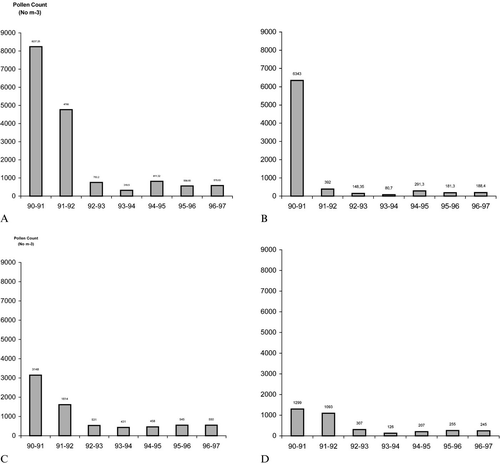
Annual total pollen concentration in 1990–97: A. Prosopis; B. Eucalyptus; C. Artemisia; D. Parthenium.
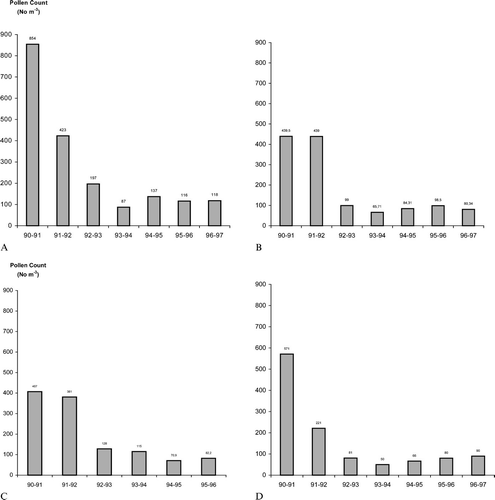
The highest annual pollen concentration (22,740 pollen m {\rm ^{ - 3}} air) was recorded during 1990–91, followed by 9787 pollen grains m {\rm ^{ - 3}} air in 1991–92. In subsequent years, total pollen concentration dramatically decreased (). Similarly, the annual concentration of Morus alba was as high as 8235 pollen m {\rm ^{ - 3}} air during 1990–91 followed by only 4765 pollen m {\rm ^{ - 3}} air in 1991–92. The concentration after that was observed to further decline to less than 1000pollen m {\rm ^{ - 3}} air (). The annual concentration of Cannabis sativa was recorded to 6342 pollen m {\rm ^{ - 3}} air in 1990–91, but decreased drastically in the subsequent years with the lowest concentration (80 pollen m {\rm ^{ - 3}} air) in 1993–94 (). The annual concentration of Poaceae pollen () varied from 3150 pollen m {\rm ^{ - 3}} air during 1990–91 to as low as 430 pollen m {\rm ^{ - 3}} air in 1993–94. The annual pollen count of Chenopod/Amaranth was 1298 pollen m {\rm ^{ - 3}} air in 1990–91, followed by 1093 pollen m {\rm ^{ - 3}} air in 1991–92 without any significant variation. However, the lowest annual concentration was only 81 pollen m {\rm ^{ - 3}} air in 1993–94 ().
The variation of the annual total pollen concentration of Prosopis, Eucalyptus, Artemisia, Parthenium, Ricinus, and Xanthium was also significant ( ).
Relative Annual Concentration
Based on average percent contribution, 10 predominant types comprised about 90% of the annual pollen concentration (). Pollen of Morus alba contributed the maximum average annual concentration with 34.2%, followed by Cannabis sativa and Poaceae which contributed 16.0% and 5.5%, respectively. The annual pollen concentration of Chenopod/Amaranth, Prosopis, Eucalyptus, Artemisia, and Holoptelea was also >1.0% of the total average.
DISCUSSION
Continuous monitoring of the qualitative and quantitative composition of airborne pollen is a prerequisite in any planned program aimed at devising an effective and efficient diagnosis and management of respiratory allergy disorders in man. The atmospheric surveys of pollen have been considered essential in studies of allergic disorders (Lewis et al. Citation1984). Delhi, the capital city of India, is inhabited by more than 11 million people and according to one of the recent surveys more than 20% of the people suffer from allergic diseases, of which 11% suffer from bronchial asthma alone (Anonymous Citation2000). Another study in Delhi reported 12% children suffering from bronchial asthma (Chhabra et al. Citation1998). The vegetation has changed considerably due to the clearing of the ground flora and introduction of exotic plants in parks and gardens. Assessing the aeroallergen load has been considered a prerequisite in the Delhi metropolis with its changing vegetation scenario during the past two decades. The present survey will provide detailed information about changing aerobiological scenario over a period of seven years. Recording the seasonal and annual fluctuations of highly allergenic pollen concentrations is helpful, besides assessing the efficacy of immunotherapy, in the diagnosis and management of respiratory allergic symptoms (Singh & Singh Citation1994).
During the seven years of pollen survey, altogether 94 types were identified either to species/genus or to family level in spite of limitation of collecting the samples from only one site. The major contributors to the Delhi atmosphere are Morus, Cannabis, Poaceae, Chenopod-Amaranth, Prosopis, Artemisia, Eucalyptus, Ricinus, Parthenium, Xanthium, and some others. Ten predominant types contributed about 90% to the average annual pollen concentration. The number of pollen types identified is larger in the present survey than the one reported earlier from the height of human breathing (Malik et al. Citation1990). This might be because here the presented survey period was seven years long and conducted at 10 m above ground level.
Seasonal Distribution
In general, two peak seasons for airborne pollen were recorded during the seven-year survey (February–April and September–November) although low concentration of pollen was recorded in all the months. The first season is dominated by pollen from tree taxa while the second one by pollen from grasses, weeds and cultivated plants. The pollen season seems to be broadly comparable with earlier surveys reported from Delhi (Citation CitationDua & Shivpuri Citation1962, Singh & Babu 1981, and Malik et al. 1990). January was invariably the month with the lowest pollen concentration each year on the contrary to the earlier reports where June was observed to have the lowest pollen contents in the air. This might be due to the changing vegetation cover in Delhi metropolis area.
Morus contributed highest pollen load (34%) to the average annual concentration with a short and precise pollen season in February–March. The pollen concentration of Morus was particularly high during the first two years of survey, after which it declined considerably. The gradual reduction is suggested to be due to the cleaning of vegetation for developmental work in and around Delhi metropolis.
The pollen of Cannabis and Poaceae together contributed around 16% of the total average annual catch. The main pollen season for Poaceae was from August to November. Although grass pollen were present throughout the year, periods of low concentrations were found in December–January and May–June each year. The low Poaceae concentration in the present survey as compared to the earlier surveys of Singh and Babu (Citation1980, Citation1982) and Malik et al. (Citation1990) is clearly indicating the clearance of ground flora for urban development in Delhi. Many vacant plots and land have been converted into high-rise buildings and industrial locations.
Pollen produced by the families of Chenopodiaceae and Amaranthaceae are difficult to separate from each other in the light microscope and they are grouped together. Two pollen seasons are recorded yearly, the first one from February to April and the second one from September to November. There seems to be a slight shift in the peak pollen season compared to the earlier reports where July–December was observed to be the main season (CitationSingh & Babu Citation1982, Malik et al. 1990). Climatic change might be the reason for this difference.
Other important airborne pollen found in the Delhi atmosphere include Prosopis, Artemisia, Eucalyptus, Parthenium and Ricinus. The peak season for these pollen are broadly in agreement with earlier reports but quantitatively their concentration is observed to be reduced significantly in the present survey. Parthenium has recently invaded practically every part of the country and flowers throughout the year. However, the Parthenium pollen concentration in Delhi is relatively low as compared to reports from other parts of the India (Citation CitationTilak & Vishwanathan Citation1980, Agashe et al. 1983, Anonymous 2000). Our observations agree with Solomon & Buell (Citation1969) who reported a reduced pollen concentration in air from United States due to the rapid urbanization and industrialization.
Some of the pollen grains from Himalayan region were sporadically recorded every year. Except Pinus and Juniperus, the Himalayan plants are not planted in the investigated area, but in some parks and gardens. Species, such as Betula, Alnus and Cedrus are absent in Delhi area and their pollen are suspected to have drifted by long distance transportation from the Northern Himalayas. Himalayan pollen in the Delhi air have been reported earlier by Singh & Babu (Citation1982) and Malik et al. (Citation1990).
Annual variations
Significant variations in annual pollen concentration during the seven-year investigation period were recorded. Long-term variations will provide an insight into the changing scenario in the vegetation due to biotic factors. The annual concentration of all the types together was reduced to less than half from 22,740 pollen m {\rm ^{ - 3}} air in to 9787 pollen m {\rm ^{ - 3}} air over a period of one year (from 1990–91 to 1991–92). In subsequent years the annual pollen concentration further declined to one tenth of what was recorded in 1990–91. A vast project on Delhi Metro Transport is currently underway and many new residential areas have been built due to population pressure. This has resulted in clearing of most of the ground flora and number of trees in Delhi.
Consequently the annual pollen concentrations of allergenic important taxa such as Morus, Cannabis, Chenopod/Amaranth, Poaceae, Prosopis, Parthenium, Eucalyptus and Artemisia were reduced significantly after 2 years of initial survey, while pollen of Ricinus did not show a significant change over the seven-year investigation period. Many vacant land- and roadsides are observed to have come up with wild varieties of castor bean plants contributing to the airborne pollen Ricinus load.
In spite of the significant decrease of the airborne pollen concentration in Delhi, the frequency of the allergic diseases has increased (Anonymous Citation2000). It is suggested that the increase in Delhi is be due to the direct and indirect effect of the pollutants on the respiratory system.
ACKNOWLEDGEMENTS
Authors are extremely thankful to Dr Alka Singh, Dr Arnima Bist and Ms Sweety Sharma for their help in daily exposure of samples from air, and Dr S.V. Gangal, former Director, Centre for Biochemical Technology, now I.G.I.B., for providing facilities and encouragement.
REFERENCES
- Agashe , S. N. , Anand , P. , Manju Nath , K. and Jacob , N. A. 1983 . Airborne pollen survey at Bangalore. . – Asp. Allergy Appl. Immunol. , 16 : 53 – 57 .
- Anonymous 2000 All India Coordinated project on aeroallergens and human health. – Rep. Min. Environ. For., New Delhi
- Brown T. Frenz D. A. Wimpsett T. L. 1993 Operating instructions for the Rotorod Sampler. – Sampling Technologies Inc.,Minnetonka MN
- Chhabra , S. K. , Gupta , C. K. , Rajpal , S. and Chhabra , P. 1998 . Prevalence of asthma in school children in Delhi. . – J. Asthma , 3 : 291 – 296 .
- Dua , K. L. and Shivpuri , D. N. 1962 . Atmospheric pollen studies in Delhi area in 1958–59. . – J. Allergy , 33 : 507 – 512 .
- Lewis W. H. Vinay P. Zenger V. E. 1984 Airborne and allergenic pollen of North America. – J. Hopkins Univ. Press, New York
- Malik , P. , Singh , A. B. , Babu , C. R. and Gangal , S. V. 1990 . Head high airborne pollen grains from different areas of metropolitan Delhi. . – Allergy , 45 : 248 – 305 .
- Nair P. K. K. Joshi A. P. Gangal S. V. 1986 Airborne pollen, spores and other plant materials of India. A survey. – Cent. Biochem. CSIR, Delhi / Natl. Bot. Res. Inst., Lucknow
- Perkins W. A. 1957 The Rotorod Sampler. Second semi-annual report of the aerosol laboratory. – Stanford Univ., Palo Alto CA
- Rawat , A. , Gaur , S. N. , Kumar , L. , Roy , I. , Ravindran , P. and Singh , A. B. 2000 . Clinical and immunological evaluation of Cedrus deodara pollen: A new allergen from India. . – Allergy , 55 : 620 – 626 .
- Singh , A. B. and Babu , C. R. 1980 . Pollen types in the atmosphere of Delhi. . – Phytomorphology , 30 : 180 – 189 .
- Singh , A. B. and Babu , C. R. 1981 . Variations in the atmospheric pollen spectra of Delhi region, India. . – Grana , 20 : 191 – 195 .
- Singh , A. B. and Babu , C. R. 1982 . Studies of atmospheric pollen allergens in Delhi: Seasonal periodicity. . – Ann. Allergy. , 48 : 115 – 122 .
- Singh A. B. Singh A. 1994 Pollen allergy: A Global Scenario. – In: Recent trends in aerobiology, allergy and immunology (ed. S. N. Agashe), pp. 143–170. – Sci. Publ. Mt. Lebanon/Oxford I.B.M. Publ. Prt. Ltd., New Delhi
- Singh , K. and Shivpuri , D. N. 1971 . Studies on yet unknown allergenic pollen of Delhi state Metropolitan: Botanical aspects. . – Ind. J. Med. Res. , 59 : 1397 – 1410 .
- Solomon , W. R. and Buell , M. F. 1969 . Effect of suburbanization upon airborne pollen. . – Bull. Torrey Bot. Club , 96 : 435 – 445 .
- Tilak S. T. Vishwanathan D. B. 1980 Aeroallergenic pollen at Aurangabad. – In: Advances in pollen – spore research. No. 5–7 (ed. P.K.K. Nair, M. Nagaraj & S.N. Agashe), pp. 145–150. – Today & Tomorrow's Pr. Publ., New Delhi
- Vishwanathan , R. 1964 . Definition, incidence, etiology and natural history of asthma. . – Ind. J. Chest Dis. , 6 : 108 – 124 .
List of pollen types identified from a seven-year atmospheric survey (1990–97) in Delhi metropolis area.
“Unknown types”
Acacia sp.
Acanthaceae
Adhatoda vasica
Aerva tomentosa
Ailanthus excelsa
Albizia lebbeck
Alnus sp.
Anogeissus pendula
Apiaceae
Arecaceae
Argemone mexicana
Artemisia scoparia
Asphodelus tenuior
Azadirachta indica
Betula sp.
Boerhavia diffusa
Bombacaceae
Bombax ceiba
Bougainvillea
Brassicaceae
Brassica campestris
Broussonetia papyrifera
Caesalpiniaceae
Cannabis sativa
Capparis decidua
Cassia siamea
Casuarina equisetifolia
Celtis sp.
Chenopodiaceae/Amaranthaceae
Cleome viscosa
Compositae
Corchorus sp.
Cupressus sp.
Cyperaceae
Dalbergia sissoo
Delonix regia
Dichrostachys cinerea
Dodonaea viscosa
Ehretia laevis
Emblica officinalis
Ephedra sp.
Eucalyptus sp.
Euphorbia hirta
Fabaceae
Fagonia cretica
Guazuma tomentosa
Grevillea robusta
Holoptelea integrifolia
Holarrhena sp.
Juniperus sp.
Justicia sp.
Liliaceae
Malvaceae
Mangifera indica
Maytenus senegalensis
Melia azedarach
Mimusops degan
Morus alba
Myrtaceae
Nyctaginaceae
Oldenlandia sp.
Papilionaceae - Leguminosae
Parthenium hysterophorus
Phyllanthus nummularioides
Pinus sp.
Plantago major
Plumbaginaceae
Plumbago zeylanica
Poaceae
Polygala sp.
Polygonum plebeium
Polygonum polygonoides
Pongamia pinnata
Potamogeton sp.
Prosopis juliflora
Psidium guaiava
Putranjiva roxburghii
Quercus incana
Ricinus communis
Rumex dentatus
Rutaceae
Salix tetrasperma
Salvadora persica
Sterculiaceae
Syzygium cumini
Tamarix sp.
Taraxacum sp.
Typha angustifolia
Typha latifolia
Urticaceae
Xanthium strumarium
Ziziphus jujuba
Zygophyllaceae
